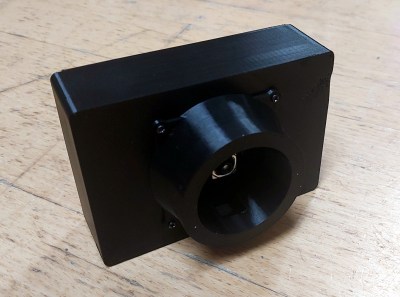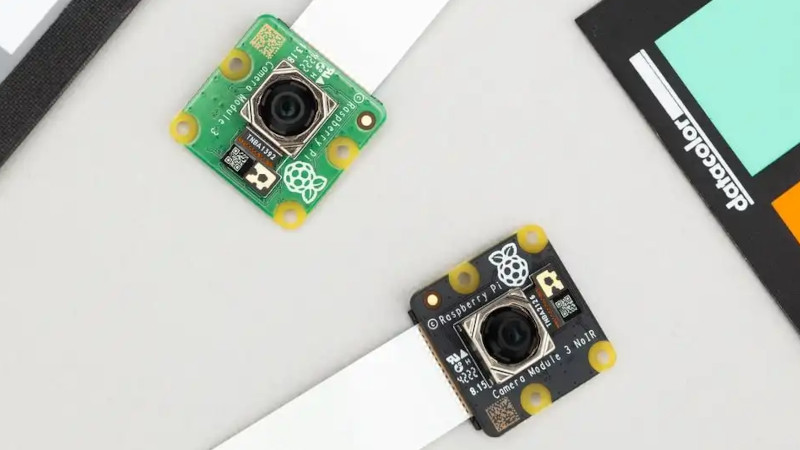This month came the announcement of some new camera modules from Raspberry Pi. All eyes were on version 3 of their standard camera module, but they also sneaked out a new version of their high quality camera with an M12 lens mount. The version 3 module is definitely worth a look, so I jumped on a train to Cambridge for the Raspberry Pi Store, and bought myself one for review.
There’s nothing new about a Pi camera module as they’ve been available for years in both official and third party forms, so to be noteworthy the new one has to offer something a bit special. It uses a 12 megapixel sensor, and is available both in autofocus and wide angle versions in both standard and NoIR variants. Wide angle and autofocus modules may be new in the official cameras, but these are both things which have been on the third-party market for years.
So if an autofocus camera module for your Pi isn’t that new, what can we bring to a review that isn’t simply exclaiming over the small things? Perhaps it’s better instead to view the new camera in the context of the state of the Pi camera ecosystem, and what better way to do that than to turn a Pi and some modules into a usable camera!
This Isn’t Just Any Camera, It’s A Hackaday Camera!

Along with the V3 non-wide-angle camera module then, I bought a Pimoroni Display HAT Mini, and a Pi Zero W. The camera module itself is the same small PCB as its predecessors, but with a slightly bigger silver protrusion around the lens for the autofocus mechanism.
My reasoning was that these parts could form the nucleus of a camera system, and to complete the hardware side I put together a camera case in OpenSCAD. It’s not that special, just a parameterised project box with cut-outs for the module and the Pimoroni display, and an impressive-looking but zero-function lens hood tube for the front.
A bit of printing and some small screws later, I had a camera, or at least something that looks a lot like one. A digital camera is nothing without software, and for the past year or two on the command line this has meant libcamera for the Raspberry Pi. You can still use the earlier software stack if you desire, but it’s no longer supported. Likewise on the programming side the Picamera Python library is being deprecated, and replaced by the picamera2 library. I was able to hack together an awful Python camera script that (slowly) updates the Pimoroni screen as a viewfinder, and uses one of its buttons as a shutter. I am no software developer, so I’m certain there will be Hackaday readers who could do a far better job.
It’s all very well to talk about the peripherals, but what matters with a camera is the pictures it takes. The sensor is a Sony IMX708, which we’re told has all of their new sensor technologies, but proves difficult to find on the Sony Semicon website. I can find reference to it being used as a secondary rear camera on some pretty recent mobile phones, if that helps give you and idea of its capabilities. The killer feature on this module is the autofocus lens, which is under full control via software and can be either set for a particular focus or put in automatic mode. My script used the latter, and I set to work taking a few pictures around my hackerspace.
Autofocus Is Where It’s At
The first thing to note is that Sony’s autofocus algorithm is very good in the automatic mode, as long as there’s something pretty clear for it to see as the subject. A close-up of some screwdriver bits or a Pi Zero came out in beautiful detail, as did a landscape scene, but looking down a table along a tape measure had it confused between the foreground, middle ground, and distance on alternate shots. The tape measure was pushing the envelope to prove a point and happily for more accomplished programmers than me there’s a windowed autofocus mode to allow more targeted focusing.
My impression of this camera module is that it’s much more of a step forward from the V2 module than the V2 was from their first model. The extra resolution is nice, but the autofocus makes it much more useful. If the HQ camera module wishes it were a mirrorless compact camera then this module wishes it were a decent quality mid-range mobile phone camera, and in this it doesn’t do too badly.
The question is then for $25 or so is it worth the outlay? I’d say yes, if you have an application for a decent quality small camera module. There are still cheaper cameras, and even other modules with autofocus to be found on the usual electronics sites, but this one isn’t too much more expensive for the benefit of much wider support. I don’t regret buying mine, and I’ll be putting some work in to making a much more efficient script for it.
Before we leave this piece, it’s worth mentioning the Raspberry Pi shop in central Cambridge, where I bought the module. It’s their public showcase to the world, but it’s also somewhere you can buy a Pi even in times of shortage if you’re prepared to make the journey. (Visit the Centre for Computing History while you’re there!) The staff are knowledgeable and helpful, and there are a few Pi prototypes to be seen at the counter. I’m fortunate in being able to get to Cambridge without too much grief, but even for those of you who can’t it’s somewhere to put on the list to visit if you get the chance.





















As not mentioned in the article, I looked it up. Yes, you can manually focus and disable autofocus on this camera as well. Which I think is also a very important feature.
I’ve been playing with the new V3 regular and V3 wide cameras for the past week. Full support in the standard OS is what makes the new focus features worth the upgrade.
I’m jealous of the ability to easily get a Pi ZeroW2 easily.
I didn’t need it nor have an immediate use. But I picked up the wide angle one as it was what was offered. Haven’t had time to hook it up yet for fun. Sometime….. Neat, compact, reasonably priced technology.
hmm might have to pick up some, last time I tried these they were notoriously shit .
I’m as confused as the chip was as to what it was supposed to focus on with the tape measure test. Should it have focused farther down the tape? If it did wouldn’t that have blurred the near part? Exactly how far down the tape is the focal point that it should have chosen?
It was a torture test for the AF system, and as expected it had difficulties. Alternate shots focus on different distances.
@Twisty Plastic
I think the fun part might have been its inconsistency. It seems to have settled on different places for each shot :-)
No. Case closed.
“somewhere you can buy a Pi even in times of shortage” ….. yeah, but at what price? £200 for a R Pi 4?
I thought I read that this year (2023) the under supply of RPIs (regular and compute) was ‘over’ with (at the ‘normal’ sell price). I haven’t seen any evidence though — yet. Luckily I have a couple 4s sitting here waiting for a place to fit into my world, and some old 3s, 2s, Zeros, and a couple Zero Ws to tide me over. Feel for those that just ‘buy’ when they have a project in mind.
Feel for those that just ‘buy’ when they have a project in mind — and can’t find any at reasonable price….
I have several projects on hold until I can find a replacement Pi for one that died several years ago. I’m not interested in paying a scalper in the interim. I was trying to contribute to the OpenFlexure project, but it will need to wait. 😟
Buy one at a (local) approved reseller. They MUST sell for reasonable prices, and get some stock regularly. At least drop them a line if they currently have none.
You’re limited to only one per person, but they had them at RRP in the Pi store in Cambridge when I was there.
It’s the official store. They sell at the official price
Does this one have DRM like the V2?
I’m very disappointed, the m12 mount version have no sense. if you want m12 you have adapters for few bucks. even if the m12 make the camera smaller could make sense but it’s the same!!!!.
the autofocus version, arducam have the same with 16 and 64mpx version before them.
still waiting for a bigger and better sensor without lens. the industry is what they need not this new toy for a few bucks(or maybe yes) but a 1 inch hq camera with high sensibillity would great for our projects
As far as I know, the AF in the Arducam is not continuous. It focuses just before starting the shot, then stays at that focus.
We have been playing with the arducam 64mp cameras (and the 64mp quad camera adapter!) And they have been doing pretty impressively good. Though it seems like arducam is struggling to keep up with the updates from Rpi, so getting started with the 64mp can be a bit clunky.
The image quality sucks. Come on, look at the ghosting: https://hackaday.com/wp-content/uploads/2023/01/pizero-closeup.jpg The picture of the screwdrivers looks like ass too.
I have the last-gen camera with the C mount, and with a Canon security-cam lens on it. Its images suck too. I wish someone would make a high-quality (even if at lower resolution) camera for this thing. But I guess it’s just not possible.
You can’t even buy a Raspberry Pi unless it’s from a soulless Scalper so why would I need a camera module?
Is this camera also locked down so you can only use it with a raspi like the other camera they sell?